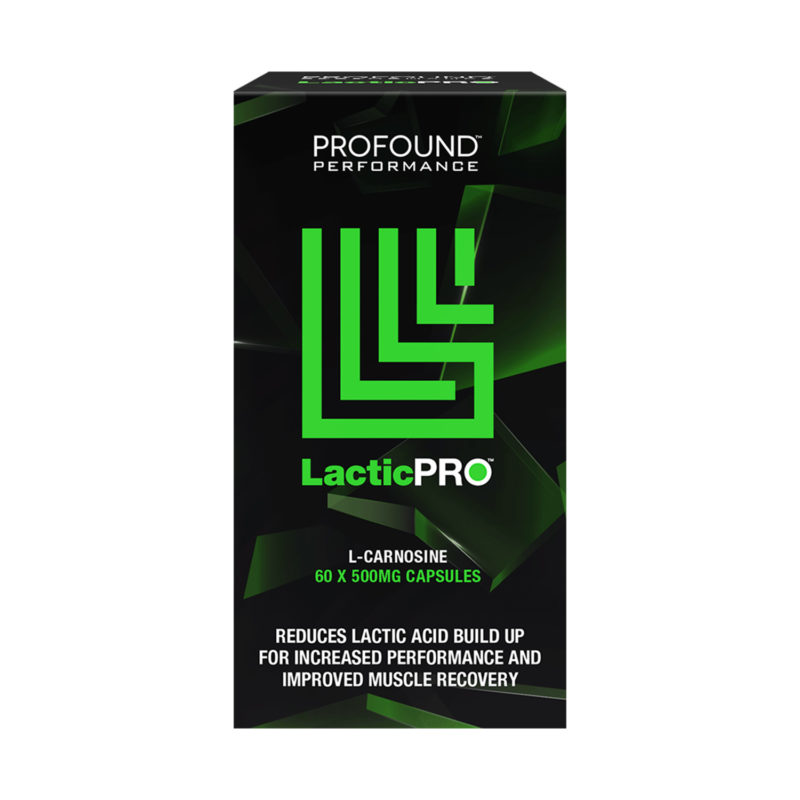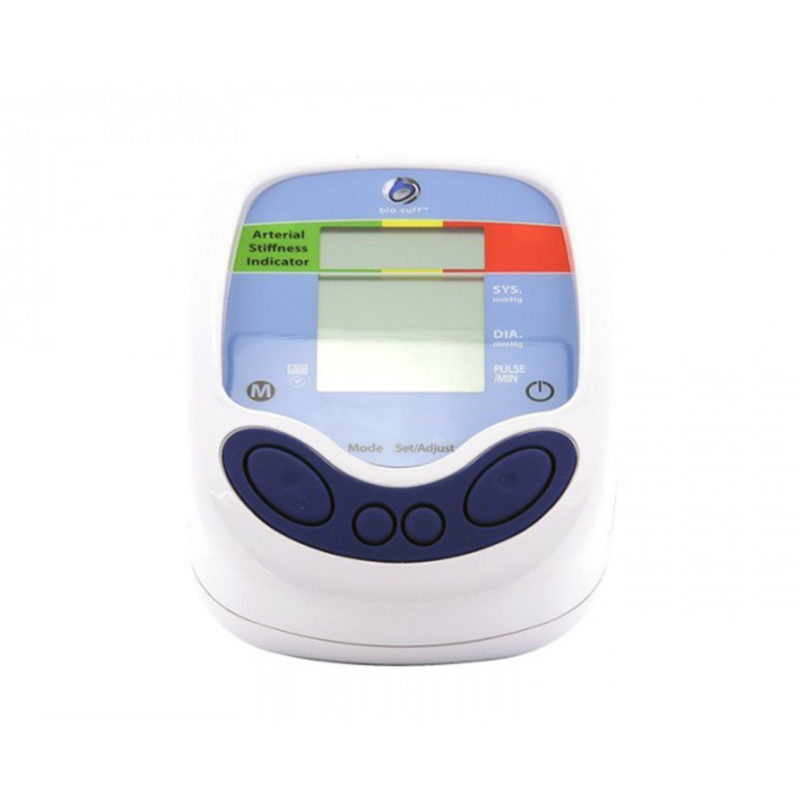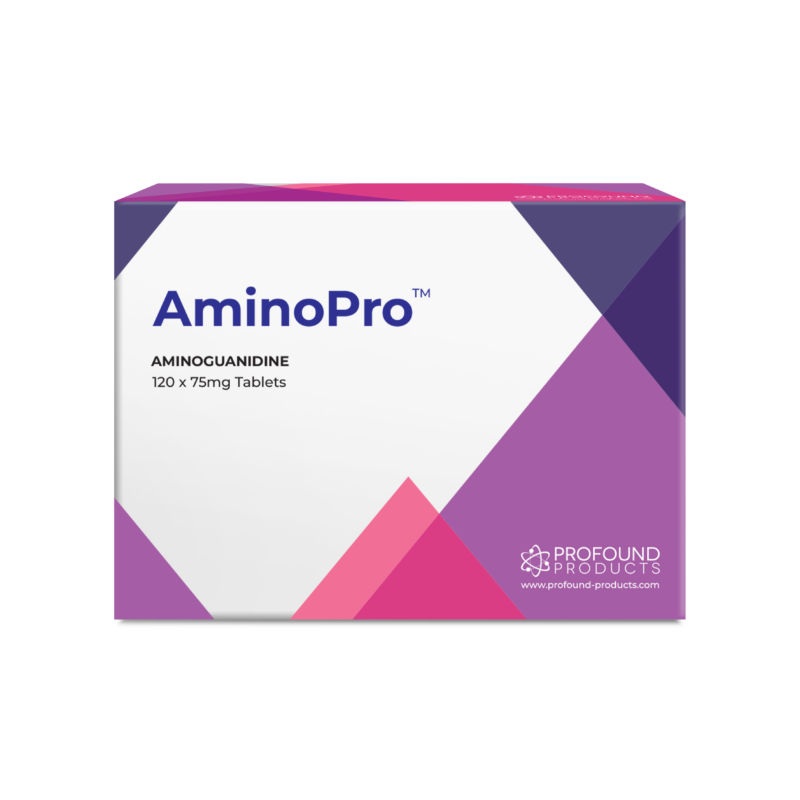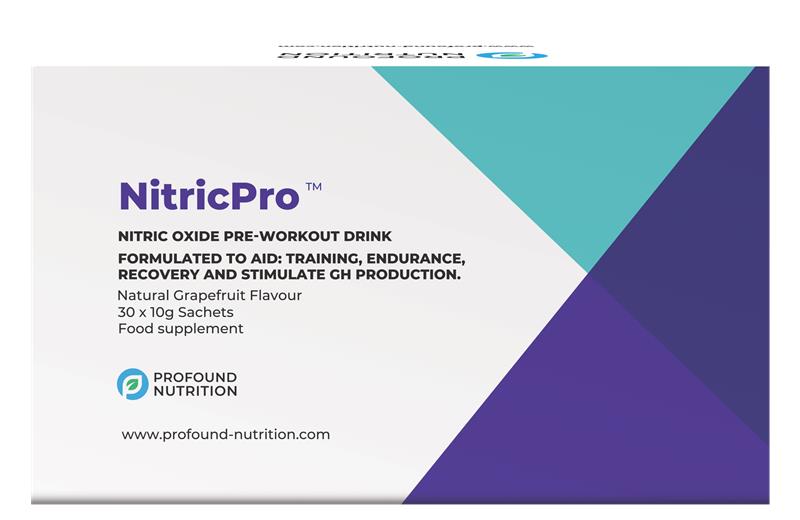Improving Your Cardiovascular Health And How To Know How Hard Your Arteries Are
It’s amazing to think that as long ago as the 17th Century Dr. Thomas Sydenham wrote that; “a man is as old as his artery.”[i] It’s taken the best part of 300 years to prove that he was correct and yet even today arterial health is not as heavily ‘relied upon’ as other cardiovascular markers- for example cholesterol. Perhaps that’s because arterial stiffness measurement has been difficult and expensive to undertake? But as you will discover in this article, that has all changed and for the first time arterial stiffness measurement has become very affordable and it can even be measured at home now!
Heart Attacks Kill
Firstly perhaps we should remind ourselves of the importance of keeping our cardiovascular system healthy. It seems an obvious statement to make- that heart attacks kill. But that’s the point, often a heart attack can strike almost without warning, a few twinges in the left arm in the morning, some heart burning sensations in the afternoon and then a little later on- bam! A full blown infarction that leads either to the emergency room or the morgue!
Compare that to cancer which typically ‘creeps up’ on a person taking time to ‘take hold’ and in theory at least gives a window of opportunity to have it treated. On that basis one could argue that it is even more important to take preventative measures to prevent a heart attack.
Of course there has been a great deal of emphasis on healthy hearts over the last few decades and it does show in the death league tables. Figure one[i] highlights that in the 1900’s most people died from infectious diseases and even respiratory diseases- heart attacks were a clear third, (note that cancer was fifth). Then in the 1950’s heart attacks were by far and away the biggest single cause of deaths and cancers were in a distant second place. But when we look at the 2000 figures, we see that despite all the adverts bombarding us with cholesterol lowering cereals and yogurts etc. and the strong emphasis that many physicians’ offices have had on cardiovascular disease, that dying from a heart attack still remains the biggest single killer (and now cancer is a close second).
Figure One:
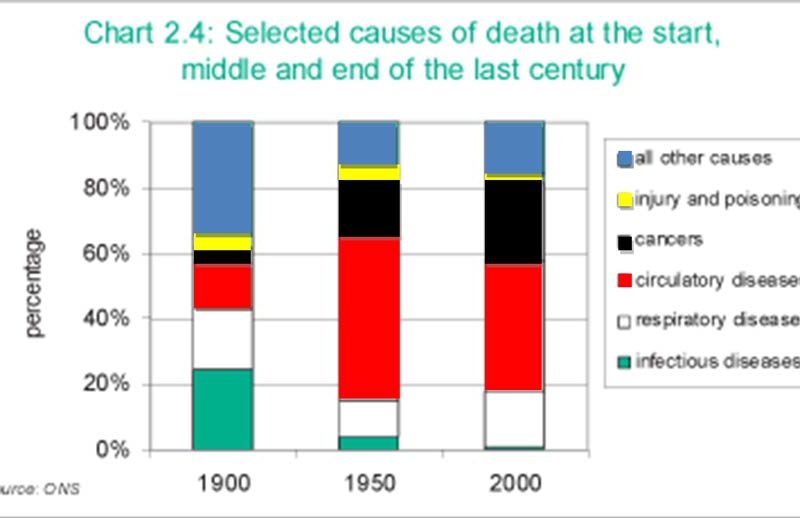
Figure one: Selected causes of death and the start, middle and end of the last century. Cardiovascular diseases remains the biggest killer. UK Centre for National Statistics.
Another way of looking at this is to review the causes of death of people who die prematurely- which for this purpose we shall say that they die before the age of 75. The top of the leader board at 18% are the people who die because of a heart condition.[i] Let’s put that another way, the general population under the age of 75 has nearly a 1 in 5 chance of dying from a heart attack.
So What’s Going On?
Without getting into a deep and technical assessment of the various cardiovascular disease risk markers, we shall name the major biochemical players here (in no particular order):
- Homocysteine
- HbA1c
- Fibrinogen
- C-Reactive Protein
- Platelet aggregation
- Heart strength
- Blood pressure
- Cholesterol (LDL/ HDL ratios)
- Atherosclerosis
- Calcification/ plaque
- Fatty deposits
- Hardening of arteries
- Poor endothelial function
It soon becomes clear that this can be a complex picture, to attempt to assess the interplay between these various fats, inflammatory agents and deposits found in the blood. Monitoring and intervening with such an array of conditions must invariably mean mistakes or oversights, even at the best of doctors offices, leaving the patient exposed to potential issues.
Are there any simpler approaches that can be taken?
The Framington Study
The Framington study is very famous in the research field because it comprises one of the largest studies ever undertaken over a long period, with more than 5000 adults being followed for more than three generations.
Their outcomes were that the uncontrollable factors involved in the risk of cardiovascular disease are:
- Age
- Race
- Family history
- Gender
And that the controllable factors for reducing cardiovascular disease are:
- Smoking
- High blood pressure
- High blood sugar
- Obesity
- Physical inactivity
- Stress
This seems like a pretty obvious list, (that’s the public’s money at work for you!) and I would personally add environmental toxins to this list- their avoidance and their reduction (through detox and chelation methods).
I’m a firm believe that we should know the basics by now and I suspect if you are reading this article that you are the kind of person that doesn’t have to be told twice, so what do we know beyond these lifestyle and diet choices?
Cholesterol – Friend Or Foe
Just before we delve into the genuine ‘antiaging medicine’ part of this heart health article, let’s cover the subject of cholesterol since it is so firmly in the public’s eye.
The basic rule of thumb is that HDL (high density lipoprotein) cholesterol is ‘good’ and LDL (low density lipoprotein) cholesterol is ‘bad.’ But according to Dr. Eric S. Rawson at the University of Massachusetts Medical School; “Cholesterol screening fails to identify 50% of the people who have heart attacks in the United States each year, because their total cholesterol is either normal or only moderately elevated.”[i] So is cholesterol a friend or a foe?
Of course nothing in life is ever that simple and if we had no cholesterol in our body we would be dead! Why? Because cholesterol is the base material (produced in the liver) that gets cleaved (methylated to be precise) by many dietary factors (B-vitamins etc) into all the hormones in our body (see figure two).
Figure two:

Figure two: The hormone tree: Cholesterol is at the base of all hormones in the body converted first into pregnenolone. Whilst this figure just shows a few of the initial examples fundamentally it highlights that cholesterol is at the root of this hormone tree.
Thus, let’s pose our first question regarding ‘high’ cholesterol levels; are they high because the body is lacking its methylation agents to convert it into the necessary hormones it requires?
Since the body cannot control its own intake of food and drink (and sunshine exposure), that’s your job- so to speak! The only way it can enable itself to make more of a required hormone is to produce more cholesterol.
Pregnenolone is the first steroid precursor made from cholesterol. But in order to make Pregnenolone, we need adequate amounts of LDL (bad?) cholesterol plus other nutrients, including vitamin A, thyroid hormones and enzymes. Pregnenolone is made inside the mitochondria and if any of these methylation materials are inadequate, then it could induce a hormonal deficiency.
Consider then that the drug to lower cholesterol levels- statins- work by inhibiting the P450 enzyme to prevent initial cholesterol production from the liver. There are frequent reports of patients not having desired cholesterol lowering despite them using statins for long periods of time- is it because the body continues to try to make more cholesterol because it needs more hormones?
By the way, it is important to know that statins also inhibit CoQ10 (coenzyme Q10) in the body. CoQ10 is a critical energy molecule that is required in multiple processes- and in heart health too. Studies show that if you are using statins then the lower your cholesterol levels the lower your CoQ10 levels will be too.[i]
Some countries (like Sweden) insist on patients taking additional CoQ10 if they are using statins, some like Germany recommend it and others like the UK and US ignore it altogether! This is a disaster, if you are taking a statin we strongly recommend that you take additional CoQ10, at least 100mg to 200mg per day.
Today there are also plenty of books on the market that highlight many of the side effects of statin drugs too, which include erectile dysfunction. One example would be ‘Lipitor, the thief of memory’ which highlights another frightening example, I say frightening because of the virtual abandon that statin drugs are prescribed.
So we know cholesterol is an important part of producing our hormones, it also forms an important part of all cell membranes, but did you know that cholesterol is also a potent anti-oxidant?
According to my good friend Rich Lippman Ph.D., cholesterol can actually neutralize one of the nastiest free radicals that can be produced in our body- the superoxide radical- and Dr. Lippman knows a thing or two because he was nominated for the Nobel Prize in medicine for his work in measuring free radical activity within the body.
So I pose a second question regarding cholesterol- are high cholesterol levels due to the body wishing to neutralize superoxide free radical activity- probably due to another event?
Let’s be clear- we are not advocating a cholesterol rich diet for antioxidant purposes! But simply pointing out that this may be one of the body’s defense mechanisms.
Lastly on this subject, another good book out there by Dr. Malcom Kendrick is called ‘the great cholesterol con.’ His conclusion is that these factors are seen in many heart disease patients:
- Raised LDL
- Lowered HDL
- Raised blood pressure
- Raised fibrinogen
- Raised PA1 (clotting factor)
- Raised Von Willibrand levels (clotting factor)
- Raised Lp(a)- clotting factor
But they are also the same factors as seen in Cushing’s disease patients, the only difference being that Cushing’s patients are recognised as having high cortisol levels!
Cortisol has been referred to as the ‘dark hormone’ because it is responsible for stress levels and one of the few hormones that can increase in aging. We know that corticosteroids inhibit the immune system and they are used to shut down an overactive immune system in cases of autoimmune diseases such as rheumatoid arthritis, asthma, eczema etc. But long term use or abuse of steroids is known to result in the same abnormalities as seen in Cushing’s disease, i.e. high blood sugar and insulin levels, low HDL, high LDL, more blood clotting factors and increased visceral fat deposits. This has certainly been seen, even in young patients who have abused steroids for the purposes of body building for example.
Another question then- is cortisol a more likely candidate as a cardiovascular marker than cholesterol? Whichever way you look at it, one conclusion can be drawn; cholesterol is not the be-all-and-end-all marker for cardiovascular health- indeed far from it.
By the way if you need to lower your cortisol levels look to Gerovital, Phenytoin or DHEA to help.
Kenneth Kensey, M.D., Opinion
Dr. Kensey is an American cardiologist and he has written an interesting book which is called ‘the blood thinner cure.’ The evaluation of numerous well known cardiovascular markers has led him to the opinion that the two most important candidates are:
- Blood viscosity (the thickness of your blood)
- Arterial stiffness
Thus, if you keep ‘thin’ (low viscosity) blood and ‘soft’ arteries then your chances of a heart attack (or a stroke) are minimal. It makes sense on two important levels, thin blood and soft arteries mean that the heart doesn’t have to work as hard to pump around the blood and flexible arteries and thin blood are less likely to coagulate thus clots are less likely to form.
Keep Your Blood Thin
So let’s start with helping to ‘thin’ our blood, Dr. Kensey’s seven steps to thinning blood are:
- Hydrate (drink fluids, especially water)
- Be active (exercise)
- Eat well (organic, unprocessed food)
- De-stress
- Stop smoking
- Take aspirin regularly
- Give blood
Of course the first 5 steps are mirroring those found in the Framington study (mentioned earlier), but let’s look at the last two- perhaps the more interesting two.
Take aspirin regularly- as a pharmacist I’ve never met a cardiologist to-date who wants to give direct dose advice, but we do know that 300 mg of aspirin releases about 2 ml of blood into the stomach, ergo aspirin is not a good long term alternative because it attacks the stomach lining, however a more typical short-term dose would be 75 mg. Personally I would recommend Resveratrol instead of aspirin (more on that later).
The last aspect of Dr. Kensey’s advice is to give blood regularly! Giving blood makes the body produces more clean cells helping to reduce its viscosity and probably also it helps to release/ remove toxins too. Regular menstruation has been cited as helping to clean out body toxins and excess iron but could it be that it also improves blood viscosity as a method to reduce the risk of heart attacks? Well according to the statistics from the American heart association twice as many men as women up to the age of 65 die of heart attacks. This is even more striking given that there are more women than men in the population aged over 35, however, guess what? Past the age of 65 women begin to catch men up and over 75 overtake men in terms of the number of heart attacks they have! Is the protection women are afforded under the age of 65 due to menstruation?
I give my blood every 4 months and conversations I have with the nurses at the time suggest that there are very varied times of extraction from patient to patient- for the donation of 1-pint. As they keep these timed records, why not ask for yours to see where you stand and if you are changing? Obviously the longer it takes to extract your blood, (the system is gravity feed so should be the same ‘pressure’ each time) the thicker your blood is at the time. I suggest that this could be a simple method to keep an eye on your blood viscosity.
Keep Your Arteries Soft
Alas there was no advice in Dr. Kensey’s book about softening arteries, so I’d like to tell you about a trial that was conducted at IAS. I hope it sheds some light onto what is possible, but just beforehand let’s look at some evidence that having ‘soft’ arteries is favorable.
Figure four shows that arterial stiffness is strongly correlated with life expectancy, in fact according to this published study[i] there are vast differences between good-normal and poor arteries, with the harder the artery the worse the risk of having a fatal cardiovascular (or stroke) event.
Figure Four:

Figure four: Arterial stiffness and longevity. Three groups of 81, 80 and 80 patients are monitored over 140 months. Those in the best (softest) artery group (12 m/s) do badly with only 10% surviving! ESRD, Blacher et al. Circulation, 1999
What’s more, arterial stiffness is known to be a good biological age marker; that is to say that in the average population arterial stiffness is expected to increase with age- this is shown in figure five.[i]
Figure Five:

Figure five: Arterial stiffness has an average linear line that increases with age making arterial stiffness a good choice for a biological age marker. Note that each dot represents a test and that at all ages, young or old, that there are some people who have good and bad arterial stiffness. Millasseau et al., Clin. Sci., 2002
How Can We Measure Arterial Stiffness?
There are several different methods, but the one that has come to the fore because of its ease of use and low cost is known as aortic pulse pressure.
The test is non-invasive (see figure six) and simply requires the user to place a finger clamp onto one of their fingers. The technology is medically recognised and known by the term photopletysmography- it passes an infa red beam through the finger tip to record the volume and speed of red corpuscles.
Figure Six:

Figure six: Photopletysmography is an established technique that passes an infra-red beam through the finger to determine the volume and speed of red corpuscles.
The speed of this movement is determined by two factors, firstly the initial ‘heart pulse’ which is the force of the expulsion from the heart through the arterial system; clearly this speed is the fastest that one can expect. But then there is also a return wave, an arterial pulse. This return pulse is dependent upon the condition of the arteries. If the arteries are hard and therefore absorb little energy, then they will return a faster wave as compared to softer arteries which absorb more energy and therefore return a slower wave. A comparison of the ‘heart pulse’ speed to the returning ‘arterial pulse’ speed determines the stiffness of the arteries.
A simple way to consider this is to imagine a pond. If you throw a stone into the middle you will watch the outbound wave it will travel at a predetermined speed, it doesn’t matter so much about the actual initial speed as the evaluation is to compare its speed with the second- returning wave. In the case of the pond, the return wave will depend on what the walls of the pond are made of, if they are hard like concrete then a faster return wave will be seen due to little energy absorption, but if they are soft like mud, then a slower return wave will be seen as much of the energy will have been absorbed.
Thus, in a similar way it is true of the arterial system and diagnostic devices like the Bio-Clip Plus (for professionals) and the world’s first arterial stiffness monitor, the Bio Clip CUFF (for individuals) can determine within 1 or 2 minutes the condition of your arteries and report that detail to you in a simple to understand manner.
What Did IAS Do?
We used a Bio-Clip™ Plus to determine the before and after results of 12 individuals who were asked not to change their diet or lifestyle in anyway; whilst this was an open trial (i.e. everyone knew what they were taking) it was based on a published in-vitro study that prevented glycosylation.[i]
Glycosylation, also known as cross-linking is a recognised theory of aging, (published by Johan Bjorksten in 1942) that describes how proteins interact with oxygen and glucose and become impaired and unable to function efficiently. Glycosylation is the process that turns food tough and yellow, (see it for yourself by cutting an apple in half and watching it deteriorate) and it is no coincidence that the same things happen in diabetes, cataracts, aged skin and indeed in arteries too.
Figure seven:

Figure seven: the impact of several agents to inhibit the process of cross-linking in-vitro (glass) is shown here. All had an effect to reduce cross linking including vitamin C, DHA (omega 3) and pyridoxal and pyridoxamine (both vitamin B6 derivatives) and aminoguanidine having the best effect- by far.
Seeing this study published in Life Sciences gave us the idea to see if similar improvements could be sought in patients using the same supplements whilst being monitored for their arterial stiffness using a Bio-Clip™ Plus device.
We also extended our study to include the natural supplements resveratrol and carnosine as there has been plenty of published information to show that these also have favorable effects.
Plus we included an aminoacid mix called Nitric – Pro™ whose primary action through arginine is to release nitric-oxide, a factor well known to dilate vessels and therefore improve blood flow etc.
Placebo
Some patients were asked not to change any of their lifestyle patterns. We took a measurement of their arterial stiffness using a Bio-Clip™ Plus (as shown in figure eight left hand side) and a month later we retook the test (as shown in figure eight right hand side).
Figure Eight:
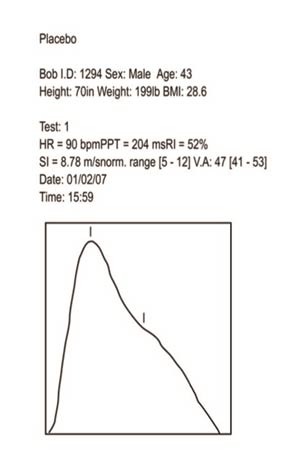
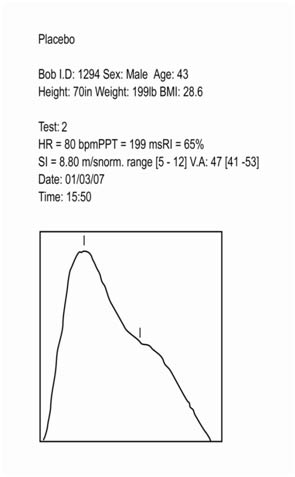
Figure eight: Before (left hand side) and after results (right hand side) of a person on placebo to establish changes to arterial stiffness- virtually none were noted.
What was clear is that very little had changed, whilst much can be transcribed from the wave form itself (I shall write a separate article on this matter for the technophiles out there), the most important number- the SI (stiffness index) was 8.78 m/s on the initial test and 8.80 m/s on the follow up. These numbers are too close to call (we usually allow a 5% variance in testing parameters anyway), thus as expected no changes in arterial stiffness were noted in the persons using placebos.
Resveratrol
Resveratrol is an interesting natural molecule we were keen to examine. This constituent of red grape skins is noted for being a significant part of the so called ‘French paradox.’ It has been shown to ‘thin’ blood and positively impact the SIR2 longevity gene etc.
Figure Nine:
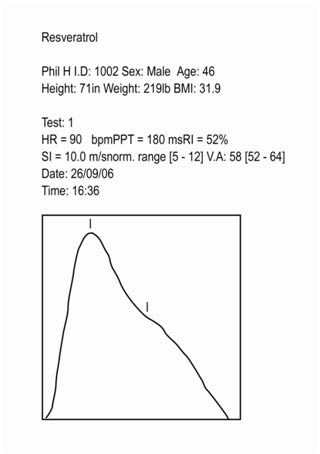
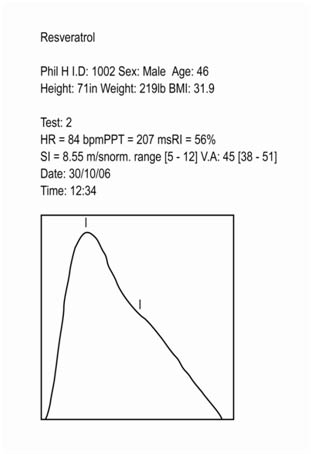
Figure nine: The impact of 45 mg of trans-resveratrol daily on this patient saw a reduction (improvement) of his SI within 5-weeks of 15%.
As can be seen in figure nine, this patient at the start had an SI of 10 m/s but after 5 weeks of 45 mg daily intake of resveratrol his SI dropped to 8.55, a reduction of 15% (remember that the lower the SI number the better).
Resveratrol works though a number of known methods including preventing the binding of cholesterol to blood platelets, (thus making them less sticky). Could it be that it is bound cholesterol levels that are important not total cholesterol levels as are usually measured?
IAS has developed a unique resveratrol containing product called Cardio Pro™ (further details are below), but for those who want to take a higher dose of resveratrol IAS do provide Resveratrol-Pro™ which has 75 mg of resveratrol per capsule.
Carnosine
Carnosine, otherwise known as L-carnosine or beta-alistine is a very interesting natural molecule, found in meats and dark green leaves; carnosine has shown itself to have significant anti-glycation properties and has found itself popular in the antiaging fraternity as well as topical skin products etc.
Our patients took 300 mg per day (the dose recommended by Dr. Marios Kyriazis of the British Longevity Society and for which there is a lengthy discussion available on the IAS website).
Figure ten shows a 45 year old woman going from an SI start point of 9.37 m/s to 7.05 m/s (representing a 25% improvement) after taking 300 mg of carnosine daily for 6 weeks. Also note that there was significant change to her waveform with the beginning of the appearance of a third wave- which is understood to be a healthy/ youthful example.
Figure Ten:

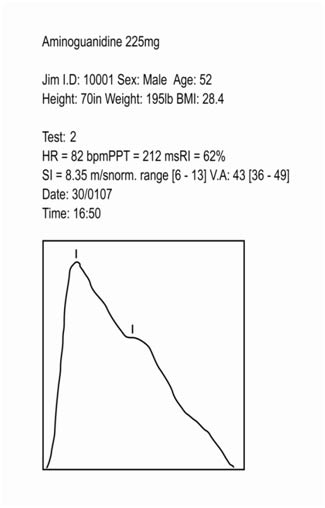
Figure ten: The results of using 300 mg of carnosine daily were significant with this woman improving her stiffness index score by 25% within 6-weeks.
IAS has developed Cardio-Pro™ which contains the same daily dose of carnosine and other beneficial ingredients. See below (under uniquely formulated) for further details.
IAS also provides carnosine capsules each of 500 mg for those folks who want to take higher doses.
Aminoguanidine
Our initial published study start-point highlighted that Aminoguanidine was the potent anti-glycator in vitro (in glass); we were keen to see if it was also the most potent anti-glycator in-vivo (in the body).
Figure eleven shows those results. It highlights that aminoguanidine did actually give the best results in this case, with a 35% improvement within just 4-weeks for a 52-year old man. His SI started at 12.7 m/s (with a poor wave form) to 8.35 m/s (with a typical wave form), he took 225 mg of aminoguanidine daily for 4-weeks.
Figure Eleven:
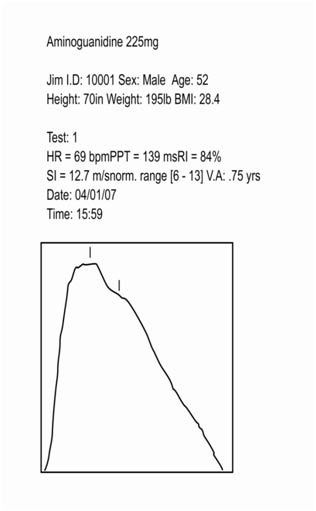
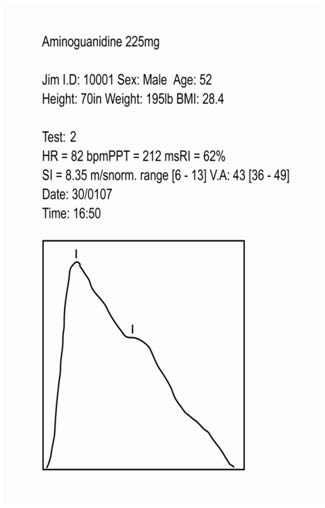
Figure eleven: the effects of 225 mg of aminoguanidine daily for 4-weeks on this 52-year old patient improved his stiffness index (SI) from 12.7 m/s to 8.35 m/s a 35% improvement.
So far, as a solo agent, aminoguanidine has been the most potent agent to reduce arterial stiffness. Aminoguanidine is related to the bi-guanidine metformin- which is an approved drug for type-II diabetes. Whilst aminoguanidine is extracted from the cat’s claw herb, some countries class it as a medicine; therefore it has not been included in multiple products like Cardio-Pro™ however IAS makes it available seperately.
The Others
Pyridoxamine, which was also used in the in-vitro study, has also been used in some patients and our results show that it is something akin to resveratrol showing a 10-15% improvement when used daily over several weeks. So this simple (but difficult to find vitamin B6 derivative) can also be a useful adjunct.
As mentioned earlier the aminoacid compound powder Nitric-Pro™ that delivers 3.5 grams of arginine per scoop was also shown to be very effective to improve SI values quickly. It’s well known that the boosting of nitric oxide in the blood, (which is the main route of efficacy of Nitric-Pro) dilates blood vessels and improves blood flow and it may also benefit the thin endothelial layer, the lining of the arteries. However whilst these values improve very quickly (often within hours) they will also pass away quickly (again within hours).
This may seem like a worthless result, but actually consider this- if you are in a high risk category and have obtained a high stiffness index result after your test, what do you do to ‘take the pressure off?’ For example immediately jumping onto a treadmill in an unfit condition may induce the very thing you are trying to avoid- a coronary! Therefore Nitric-Pro may provide relief to at least get starting and into a program of change through diet, lifestyle, exercise and using the ‘longer term’ supplements that benefit- such as the ones that are mentioned above in this article.
Cardio-Pro Was Uniquely Formulated
Cardio-Pro™ was the product that IAS specially formulated for ‘the masses’ from the results of this trial to help reduce everyone’s arterial stiffness.
Each Cardio-Pro capsule contains 15 mg of resveratrol and 100 mg of carnosine and also includes rare trace minerals important for heart health that is regularly missing in the modern diet including boron, palladium and lithium. Three capsules can be taken each day at breakfast (with food) and as of February 2010 that cost is less than $30 a month.
Conclusions
Arterial stiffness according to data on file at MicroMedical in the UK can vary by about 10% over the course of a day. This surprises a lot of people because the assumption is often that arteries are like drainpipes- fixed, but they are made of flexible material and layers such as the endothelial layer are in some places just 1 molecule thick, therefore changes in hormonal levels and other stress factors such as running for the bus, getting a rollicking from the boss or paying your tax bill could act as effectors. But why shouldn’t arterial stiffness change slightly in the same way that blood pressure will change depending on whether you are sleeping or being active etc? Therefore it’s likely that food and drink will change parameters too (probably in both directions depending on what is consumed).
Why do I mention all of this? Because I pose the question, what is it that tips the balance? Why does the heart attack occur at that moment? Well maybe if you are in the ‘risk zone’ and your current activity raises that arterial stiffness by that 5-10% factor, then perhaps that’s the point that puts you over the top. For example, it’s no word of a lie that a lot of people die on the toilet as they strain themselves, which was the unfortunate outcome of the late great Elvis.
But if you know where you stand in terms of your arterial stiffness, then you can help yourself to stay outside of the danger zone. You can adjust your habits and your supplements to suit and by using a Bio-Clip Plus or Bio-Clip Cuff you can even see how effective those changes are that you are making. If they are working, keep them up; if they are not- then you have the opportunity to change them.
The arrival of these cost effective devices will take away the ‘faith’ you have in your health program and replace it with proof!
Meanwhile, the great news is that there are a number of methods that can help to improve arterial stiffness and significant results can be seen within a month. I hope that the examples I have shown here point towards that fact.
What Is The Real Breakthrough Here?
The fact is that the Bio-Clip™ Plus and the new at-home (a simpler unit of course) Bio-Clip™ Cuff devices have taken much of the guesswork out of knowing the condition of your arteries. Now you can know where you stand and how much your new lifestyle and supplement program is aiding you.
In my opinion this takes the whole preventative health market onto the next level- by adapting personalized programs that can be tested again and again with the knowledge of real time results.
In other words, where is your cardiovascular health now and where will it be in the months and years to come? You won’t know for sure until you are tested and furthermore with your own access to a Bio-Clip you have the opportunity to indulge in the ultimate individualized health program of measure-treat-measure.
References
- US National Institute on Aging
- UK Centre for National Statistics
- UK Department of Health 1999
- Stated in the journal of Medicine, Science, Sports & Exercise.
- Suzuki T, et al. Atorvastatin-induced changes in plasma coenzyme Q10 and brain natriuretic peptide in patients with coronary artery disease. Int Heart J. 2008;49:423–433.
- ESRD, Blacher et al. Circulation, 1999
- Millasseau et al., Clin. Sci., 2002
- Khatami et al, Life Sciences 1988
